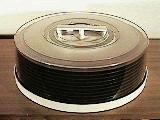|
|
|
|
|

CMX was formed as a joint venture between CBS and Memorex. There goal was to produce a revolutionary new offline video editing system. This system stored the video on computer disks, which provided instant access to both picture and sound, and the ability to make, and see, changes in real time. This new systems was called a Random Access Video Editor (R.A.V.E). Adrian Ettlinger, of CBS, provided the concept for the new system, and Memorex, then heavily involved in data recording, provided the disk recording technology. The left hand monitor showed the edited sequence. You could at any time play the sequence, forward, or backward, and at a variety of speeds. As simple as the control console was, the equipment necessary to make the 600 preform its magic was substantial. The CMX-600 consisted of, an ASR-33 Teletype which was used to control the recording process, and to input, and, output the Edit Decision list. The electronics for the 600 filled two equipment racks. The first held the monitoring equipment, PDP-11 computer, with its 16k of memory, and interface electronics. The second held the video and audio signal systems, and most important, the "Skip Field Recorder" (more about this in a moment). And finally, the Disk drives. The CMX-600 could support up to six (6) disk drives. Each drive was about the size of a washing machine, and required 220v 3-phase power. With six drives, the system could store 27-minutes of audio and video. In order to maximize the recording time, only one field of each TV frame was recorded. Using the Skip Field Recorder, audio from both fields were combined with the single field of video, and recorded on the disk drives. Each track on the disk held one video field with audio from both fields. The recording was analog, and the audio was stored in the video's horizontal interval. During playback the Skip Field Recorder was used to artificially create an interlaced picture, by first playing back the field without delay, then playing it back with a one-half line delay.  Each disk drive held one disk pack. These disk packs have 11 platters (20
recording surfaces), each platter is
14" in diameter. The disk pack holds a total of 39-megabytes of data.
Each disk drive held one disk pack. These disk packs have 11 platters (20
recording surfaces), each platter is
14" in diameter. The disk pack holds a total of 39-megabytes of data.
 to Offline to Offline
|